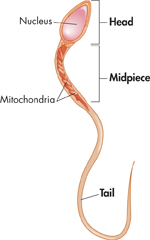Quick Lab
GUIDED INQUIRY
Tracing Human Gamete Formation
Recall that cells in the testes and ovaries undergo meiosis as they form gametes—sperm and eggs.
For each letter, indicate how many chromosomes are in the cells at that stage and whether the cells are diploid (2N) or haploid (N). Answers a. and e. have been provided for you.
Interpret Visuals For every cell that undergoes meiosis in a male or female, what is the ratio of sperm produced in males to eggs produced in females?
Infer What percentage of sperm cells will contain a Y chromosome?
Analyze and Conclude

FIGURE 34–12 Sperm A large number of mitochondria are required to power a sperm cell's trip through the female reproductive system. If a sperm reaches an egg, enzymes in the sperm's head can break down the egg's outer layer.
dGlands lining the reproductive tract—including the seminal vesicles, the prostate, and the bulbourethral (bul buh yoo REE thrul) glands—produce a nutrient-rich fluid called seminal fluid. The seminal fluid nourishes the sperm and protects them from the acidity of the female reproductive tract. The combination of sperm and seminal fluid is known as semen. The number of sperm present in even a few drops of semen is astonishing. Between 50 million and 130 million sperm are present in 1 milliliter of semen. That's about 2.5 million sperm per drop!
Sperm Release When the male is sexually aroused, the autonomic nervous system prepares the male organs to deliver sperm. The penis becomes erect, and sperm are ejected from the penis by the contractions of smooth muscles lining the glands in the reproductive tract. This process is called ejaculation. Because ejaculation is regulated by the autonomic nervous system, it is not completely voluntary. About 2 to 6 milliliters of semen are released in an average ejaculation. If the sperm in this semen are released in the reproductive tract of a female, the chances of a single sperm fertilizing an egg, if one is available, are very good.
Sperm Structure A mature sperm cell consists of a head, which contains a highly condensed nucleus; a midpiece, which is packed with energy-releasing mitochondria; and a tail, or flagellum, which propels the cell forward. At the tip of the head is a small cap containing enzymes vital to fertilization.
 In Your Notebook Make a flowchart that shows the path of developing sperm through the male reproductive system.
In Your Notebook Make a flowchart that shows the path of developing sperm through the male reproductive system.
Table of Contents
- Formulas and Equations
- Applying Formulas and Equations
- Mean, Median, and Mode
- Estimation
- Using Measurements in Calculations
- Effects of Measurement Errors
- Accuracy
- Precision
- Comparing Accuracy and Precision
- Significant Figures
- Calculating With Significant Figures
- Scientific Notation
- Calculating With Scientific Notation
- Dimensional Analysis
- Applying Dimensional Analysis





